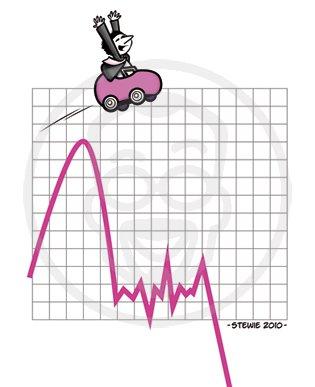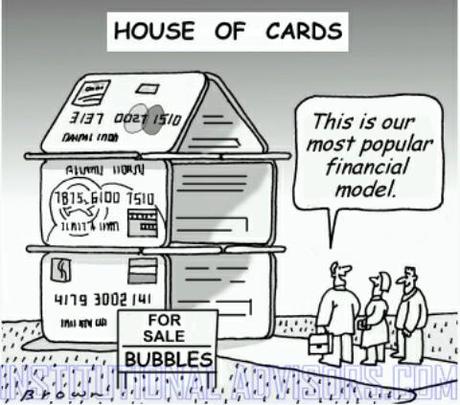Our goal was to set up a virtual portfolio of $500,000 that produces at least $4,000 a month in income and we are miles ahead of goal already with only a little bit of our cash deployed and we haven’t even hit our first dividend cycle! So we are loving a market sell-off as it gives us more buying opportunities as stocks we want go on sale.
Keep in mind we are trying to establish a low-touch retirement virtual portfolio so we’re not "going for it" with these positions as we are with the $25,000 Virtual Portfolio, which is already up 38% in 3 months on very aggressive (and often gut-wrenching) positions. The goal of that virtual portfolio is to practice rolling and saving the positions that go against us and it requires almost daily care. This virtual portfolio is designed for my Mom, who has no time or interest to play the markets on a daily basis but would like to be a little more aggressive with her money than the 6.7% returns she’s been getting from the very conservative account my Dad had set up.
I wanted to keep her money with the guys she has but the fee structure alone made it ridiculous. It’s not just the obvious fees they charge for managing money but outrageous rates they charge for stock transaction and margins – no wonder the Financial Sector is having such a good year – they get free money and rip off the people who have scrambled into "safer" accounts by hitting them with endless fees.
Just because you are retired, doesn’t mean you can’t manage your own money – on a $500,000 account, you can save $10,000-$15,000 a year just from that – isn’t that worth skipping one round of golf per month for?
So it’s a low-touch but not no touch virtual portfolio and one of the things we do to make a little extra cash with our sideline margin is sell puts in companies we REALLY want to own at the net strike (if put to us). One of those trade ideas was selling 20 INTC May $20 puts for .75 ($1,500) back on April 9th (12th actually as the post was from the weekend) and we bought that one back early for a dime, making a nice, early $1,300 profit. Now, how much effort did that take to make $1,300? What were the mechanics of the trade?
INTC was at $20 at the time and we REALLY wanted to buy it for net $19.25. Alas, that was not to be as INTC flew up after earnings but our consolation prize is we get to keep $1,300 for doing nothing. I will point out that on 4/18 those puts were down 33% as they hit .99 when INTC touched $19.50 and you do need to get used to that when you sell puts – it’s not a loss until you panic and cash it out – that’s a lesson from the $25KP!
If you stick to stocks and positions that you really, really believe in for solid, fundamental reasons and you are willing to accept a long-term ownership of the stock or ETF as a fall-back, there are always ways to adjust ownership plays – it’s the trades where you make bets where you are the sucker who BUYS premium that can’t be fixed. Those we avoid like the plague in our retirement virtual portfolios. Other ownership plays we made by selling short puts were:
- Sell 10 KO May $65 puts for .65 ($650), now .05 (up $600)
- Sell 20 PFE May $20 puts for .47 ($940), now .05 (up $840)
- Sell 10 T May $30 puts at .45 ($450), now .03 (up $420)
- Sell 10 KFT Jan $30 puts at $1.60 ($1,600), now .75 (up $850)
- Sell 10 EXC Jan $37.50 puts at $2.20 ($2,200), now $1.50 (up $700)
- Sell 10 HCBK Jan $10 puts at $1.50 ($1,500), now $1.35 (up $150)
- Sell 10 GE 2013 $17.50 puts at $2.10 ($4,200), now $2.10 (even)
Last time we did a review on the 24th, the PFE puts were $680 against (down 72%) us but we didn’t panic did we? That Friday, PFE has spiked down to $19.50 but SO WHAT? We REALLY WANTED to own them at net $19.53 so the TRANSIENT price of the option at any given time is irrelevant. This is why these virtual portfolios are a great exercise – it takes a lot of experience to get used to riding out option positions, just like it takes off-road racers a lot of practice to get used to turning into the skids and accelerating, when instincts say otherwise.

If PFE fell to $19 the short option, would have been down over 100% but what’s the reality of the situation? All that can happen is we are assigned 200 shares of PFE at net $19.53 with the stock at $19, that’s down $106 out of $3,906 – IT’S JUST 2.7% PEOPLE – that’s why you need to have perspective and why we don’t freak out about option PRICES – especially when our goal is to be long-term holders of the underlying position.
So, now we are looking good on our KO, PFE and T positions and it looks like we won’t be getting any of those positions, even with the recent sell-off. As we think the market is heading lower next week, we’re not going to sell more puts right now – remind me to put out an Alert during the week when we think we have a bottom and we can try to buy 4 or 5 more stocks cheaply for June and, if not, we’ll just end up having to take the extra couple of thousand Dollars instead.

Now that we all understand the concept of ON TRACK, I’m not going to spend the next 18 months discussing every monthly move of our 2013 spreads. We have a net entry and we have a current price – if they deviate by more than 10%, THEN we’ll want to do something.
- 3,000 NLY 2013 buy/write at net $11.26/13.15 (only 15 puts sold), now $17.67 – No cash taken. .62 dividend expected 6/30 ($1,860)
- 2,000 AGNC June covered at net $27.21, now $29.62 – $2,200 withdrawn. $1.40 dividend expected 6/30 ($2,800).
- 3,000 FTR 2013 buy/write at net $5.69/6.60, now $8.66 - $1,800 withdrawn. .19 dividend expected 6/30 ($570)
- 2,000 GLW 2013 buy/write at net $16/18, now $20.73 - There is a stop on the stock at $20! .05 dividend expected 5/30 ($100)
- 20 short GLW Aug $20 calls at $1.30, now $1.60. This is, of course a silly price (net $18.40) with GLW at at $20.73 so I love it as a new, naked trade - $2,050 withdrawn.
- 1,000 CSCO 2013 buy/write at net $11.92/14.71, now $16.88. .06 dividend expected 6/30 ($60)

All in all, we’ve deployed less than $150,000 of our cash and about the same in margin, just 30% of our buying power yet we’ve already withdrawn $6,050 in our first month and it looks like another $2,040 will be coming our way when the short May puts expire plus we banked $1,300 on the Intel trade already. That puts us more than a month ahead in our 5th week! Then comes the end of June and we have $5,390 worth of dividends coming to us. Not bad for our first quarter with 70% of our cash still on the sidelines – and we’re well-hedged!
Never underestimate the value of cash as investment protection, especially now as the Dollar seems a bit undervalued still. Keeping in mind that we don’t really need to guard against a huge dip, it would still be nice to profit from one so let’s set up another spread, using my favorite ETF hedge, the DIA’s. As they have March options, we can do a nice put spread, like IYR, which will give us a good chance of paying it off over time:
- 50 DIA March 2012 $110 puts at $4.15 ($20,750)
- 25 short DIA June $120 puts at .85 ($2,125)

Not only that, but our delta will increase as the Dow heads lower AND the VIX will increase, which will also add to the PRICE of our long puts. On the way up, even with the offsets of the short puts we have a very real danger of losing $10,000 so it is advisable to use a stop on the uncovered half at $3.15 for a $2,500 loss there. With a delta at .23 that declines as the Dow moves higher, we can assume that’s 500 points up from here, past Dow 13,000 so it’s not like we expect to be spiked out of the position. Still, if you must use hard stops, try to base them on the last price paid for the contracts, not the bid or the ask as those can be some very wild numbers!
Don’t forget to remind me we need more short put plays if the market gets back to our reference lines (as we expect) and holds them and we’ll certainly need more long plays to offset our new DIA hedge if the market heads higher. This will be the cycle for this virtual portfolio – options expiration weeks are when there is work to be done but it should usually be the Wednesday, Thursday and Friday of that week so – happy sailing!

